What is kapos? sarcoma?
Kaposi's sarcoma (KS) is a disease of the endothelial cells of blood vessels and the lymphatic system. Despite its name, it is no longer classified as a sarcoma (which is a evil one tumor of mesenchymal origin) because it is multicentric vascular hyperplasia.
There are four types of Kaposi's sarcoma.
- Classic type of Kaposi's sarcoma: This affects older men of Mediterranean and Middle European descent and in men from sub-Saharan Africa. It is associated with diabetes mellitus, but not with HIV infection.
Human immunodeficiency virus (HIV)-associated Kaposi's sarcoma: This mainly affects men who have sex with men (MSM). Kaposi's sarcoma is one of the most common forms of Cancer in Uganda and Zambia, especially in children.
- Endemic or African Kaposi's sarcoma: arises in some parts of Africa in children and young adults.
- Iatrogenic Kaposi's sarcoma: as a result of drug treatment that causes immunosuppression.
In the United States, Kaposi's sarcoma was particularly common in the 1980s. predominant Among HIV positive men who have had sex with men (MSM), in which it has a very aggressive course. It occurs less frequently in intravenous drug users and is rare in women, hemophiliacs, or their sexual partners. HIV-associated Kaposi's sarcoma is more common in women than men in some parts of Africa. It has become less common in the United States and Europe due to highly active antiretroviral treatment (HAART) for HIV.
Iatrogenic Kaposi's sarcoma is a particular concern for the organ transplant patients, especially in geographic areas associated with high levels of infection with Kaposi's sarcoma herpes virus (KSHV). Most have the virus before transplant, but the drugs make it reactivate. Use of corticosteroids and biologics such as rituximab, infliximab, and abatacept, prescribed for chronic inflammatory and autoimmune conditions, they are also likely to develop Kaposi's sarcoma.
What is the cause of Kaposi's sarcoma?
Kaposi's sarcoma has several causes.
- Kaposi sarcoma herpes virus (KSHV) infection. This virus is also called human herpesvirus 8 (HHV8). It is most often found in MSM but has been seen in heterosexuals. Evidence is emerging that non-sexual modes of transmission may occur, possibly through saliva or arthropod bites.
- It is also associated with the production of specific products. cytokines or cell signaling proteins, genetic factors, hormonal factors and immunodeficiency. Decreased CD4 cell counts have a strong association with classic and AIDS-associated Kaposi's sarcoma.
KSHV can remain dormant or replicate and cause disease. KSHV can also cause some forms of non-Hodgkin's. lymphoma and Castleman's disease.
How does Kaposi's sarcoma present?
Kaposi's sarcoma appears red to purple. macules, papules and nodules anywhere on the skin mucous membranes lining the mouth, nose, and throat; lymph nodes; or other organs Initially, the lesions are small and painless, but may ulcerate and become painful.
There are several ways:
- Located nodular Kansas
- locally aggressive KS
- Generalized lymphadenopathic Kansas
- Patch KS stage
- Located plates from KS
- exophytic KS
- Infiltrative KS plates
- Disseminated cutaneous and visceral Kansas
- Telangiectatic KS
- Keloidal KS
- ecchymotic KS
- KS similar to lymphangioma/cavernous.
Kaposi's sarcoma often begins as flat patches on one or both legs, often in association with lymphedema. The patches evolve into plaques, nodules, or scaly tumors
Kaposi's sarcoma in association with HIV infection can develop at any time during the disease. Generally, the greater the immunosuppression (eg, with CD4 cell counts less than 200/mm3), the more extensive and aggressive the Kaposi's sarcoma.
Kaposi's sarcoma lesions can also occur internally; in the intestine, lungs, genitals, lymphatic system and other places. These internal injuries can cause symptoms such as:
- discomfort when swallowing
- Bleeding
- Hematemesis
- hematochezia
- Melanie
- Intestinal obstruction
- Short of breath
- swollen legs
Kaposi's sarcoma
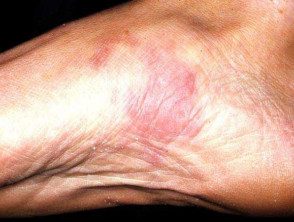
Patch stage KS
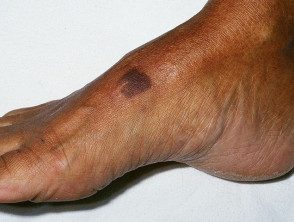
KS plate stage
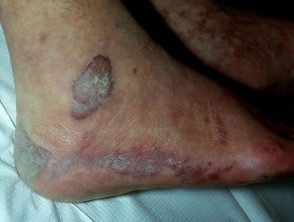
Classic KS
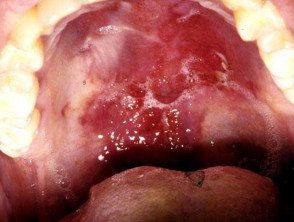
Palatal KS
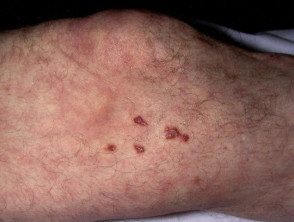
KS plate stage
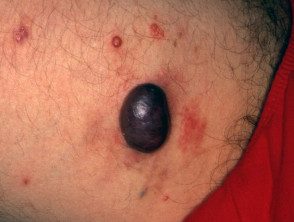
KS tumor stage
See more images of Kaposi's sarcoma.
How is Kaposi sarcoma diagnosed?
Blood tests may show no abnormality, depending on whether there are associated disorders, such as AIDS. Anemia can arise if there is bleeding. KSHV assays or antibody KSHV titles are difficult to interpret. CD4 lymphocyte account and plasma HIV load studies are performed in patients with HIV infection.
The appearance of Kaposi's sarcoma lesions is often typical, but a skin biopsy of a injury allows a definitive diagnosis, since other conditions such as melanoma, fungal infections, and mycetoma mimic Kaposi's sarcoma in appearance and location. the histopathology of Kaposi's sarcoma shows red blood cells in slit-like spaces formed by atypical spindle cell proliferation of endothelial cells and associated with inflammatory cells.
staging and forecast in Kaposi's sarcoma
There have been several attempts to classify Kaposi's sarcoma, depending on whether it is localized or disseminated to the skin, and whether there is a lymph node or internal organ involvement. The degree of immunosuppression present can also be used in staging systems.
Kaposi's sarcoma has a variable course. Some patients develop only a few minor skin lesions, while others have extensive external and internal disease. The latter injuries can cause fatal complications from bleeding, obstruction, or drilling of an organ Kaposi's sarcoma is not curable, but it can be treated and its symptoms controlled.
What is the treatment for Kaposi's sarcoma?
In HIV disease, if the lesions are not extended or problematic, often the best approach is to treat the underlying HIV infection with combinations of highly active antiretroviral drugs that suppress HIV replication (HAART).
- HAART medications reduce the frequency of Kaposi's sarcoma and may also prevent its progression or the development of new lesions.
- Improved immune function is believed to result in reduced levels of tumor growth promoting proteins.
- HAART plus chemotherapy It is found to be more effective than HAART alone or chemotherapy alone in the treatment of Kaposi's sarcoma.
Iatrogenic Kaposi's sarcoma may improve or disappear if immunosuppressive medication can be stopped.
The choice of a more specific treatment depends mainly on the extent of the disease.
Treatment of localized lesions.
Small, localized lesions are usually only treated if they are painful or causing cosmetic problems. It should be noted that the lesions tend to recur after local treatments. Treatments include:
- Cryotherapy with liquid nitrogen
- Radiotherapy. This is most useful for classic Kaposi's sarcoma and less effective for HIV-associated disease.
- Surgical excision of individual nodules.
- To be pulsed dye laser therapy or pulsed carbon dioxide laser
- Injection with anticancer drugs such as vinblastine
- Current alitretinoin application gel (Panretin®). This drug is not yet available in New Zealand.
Electrochemotherapy, a new treatment that uses electrical impulses to improve the effectiveness of bleomycin or cisplatin injected into tumors.
Treatment of extensive or internal injuries with systemic therapy
A combination of anticancer drugs is given, but at lower doses than usual if there is immunosuppression.
Other chemotherapy treatments used in some international centers include bleomycin, etoposide, paclitaxel, docetaxel, and liposomal forms of the conventional anticancer drugs doxorubicin or daunorubicin. Liposomal means that the drugs are coated in tiny bubbles of fat, or liposomes, which allows for better absorption, resulting in fewer heart problems. toxicity and myelotoxicity. Paclitaxel is approved for use in late-stage Kaposi's sarcoma or as a second-line option.
Immunotherapy includes the use of interferon alfa and imiquimod, sirolimus, and thalidomide.
Kaposi's sarcoma can arise in organ transplant patients. Switching from cyclosporine to sirolimus (rapamycin) has resulted in resolution of the sarcoma. This is mainly attributed to the antiproliferative and antiangiogenic effects of sirolimus (mTOR inhibitor).
Clinical trials on a wide range of other therapies are ongoing.
- Photodynamic The therapy is a combination of a photosensitizer and light energy.
Isotretinoin is a vitamin A derivative that is commonly used to treat acne.
Bexarotene is used for skin treatment T cell lymphoma
- Cytokine inhibitors (biological)
- The pregnancy hormone, human chorionic gonadotropin (HCG); Kaposi's sarcoma lesions go away in some women when they become pregnant.
- Ganciclovir, cidofovir, and foscarnet (antiviral rates of Kaposi's sarcoma have recently been reported to be lower among people receiving treatment for CMV retinitis (inflammation of the retina caused by cytomegalovirus) and are currently being studied. Acyclovir, another antiviral, has been tried, but it doesn't seem to work.
- Targeting the vascular endothelium growth factor (VEGF): Drugs that act on VEGF receptors, such as bevacizumab and sorafenib, are being tested.
- The immunomodulatory agent lenalidomide is also in the testing phase.

